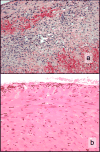Ectopic expression of Fas Ligand on cardiomyocytes renders cardiac allografts resistant to CD4(+) T-cell mediated rejection
- PMID: 25497973
- PMCID: PMC4298462
- DOI: 10.1016/j.cellimm.2014.11.007
Ectopic expression of Fas Ligand on cardiomyocytes renders cardiac allografts resistant to CD4(+) T-cell mediated rejection
Abstract
Fas Ligand limits inflammatory injury and permits allograft survival by inducing apoptosis of Fas-bearing lymphocytes. Previous studies have shown that the CD4(+) T-cell is both sufficient and required for murine cardiac allograft rejection. Here, utilizing a transgenic mouse that over-expresses Fas Ligand specifically on cardiomyocytes as heart donors, we sought to determine if Fas Ligand on graft parenchymal cells could resist CD4(+) T-cell mediated rejection. When transplanted into fully immunocompetent BALB/c recipients Fas Ligand transgenic hearts were acutely rejected. However, when transplanted into CD4(+) T-cell reconstituted BALB/c-rag(-/-) recipients, Fas Ligand hearts demonstrated long-term survival. These results indicate that Fas Ligand over-expression on cardiomyocytes can indeed resist CD4(+) T-cell mediated cardiac rejection and suggests contact dependence between Fas Ligand expressing graft parenchymal cells and the effector CD4(+) T-cells.
Keywords: Fas Ligand; Rejection; Transplantation.
Copyright © 2014 Elsevier Inc. All rights reserved.
Conflict of interest statement
The authors declare no conflicts of interest.
Figures



Similar articles
-
Prevention of acute murine cardiac allograft rejection: anti-CD4 or anti-vascular cell adhesion molecule one monoclonal antibodies block acute rejection but permit persistent graft-reactive alloimmunity and chronic tissue remodelling.J Heart Lung Transplant. 1997 Sep;16(9):889-904. J Heart Lung Transplant. 1997. PMID: 9322138
-
Intrathymic alloantigen-mediated, tolerant, completely major histocompatibility complex-mismatched mouse hearts are specifically rejected by adoptively transferred anti-class I L(d+)-specific 2C cells.Surgery. 2000 Aug;128(2):206-12. doi: 10.1067/msy.2000.107377. Surgery. 2000. PMID: 10922993
-
Overexpressed exogenous IL-4 And IL-10 paradoxically regulate allogenic T-cell and cardiac myocytes apoptosis through FAS/FASL pathway.Transplantation. 2008 Feb 15;85(3):437-46. doi: 10.1097/TP.0b013e31816026e7. Transplantation. 2008. PMID: 18301335
-
Apoptosis in heart transplantation.Coron Artery Dis. 1997 Oct;8(10):617-21. doi: 10.1097/00019501-199710000-00004. Coron Artery Dis. 1997. PMID: 9457443 Review.
-
Can expression of CD95 (Fas/APO-1) ligand on grafts or tumor cells prevent their rejection?Springer Semin Immunopathol. 1998;19(3):311-22. doi: 10.1007/BF00787228. Springer Semin Immunopathol. 1998. PMID: 9540159 Review. No abstract available.
Cited by
-
Effects of Veratrilla baillonii Extract on Hepatic Gene Expression Profiles in Response to Aconitum brachypodum-Induced Liver Toxicity in Mice.Front Pharmacol. 2019 May 31;10:568. doi: 10.3389/fphar.2019.00568. eCollection 2019. Front Pharmacol. 2019. PMID: 31214025 Free PMC article.
-
Immune Tolerance for Autoimmune Disease and Cell Transplantation.Annu Rev Biomed Eng. 2016 Jul 11;18:181-205. doi: 10.1146/annurev-bioeng-110315-020137. Epub 2016 Feb 24. Annu Rev Biomed Eng. 2016. PMID: 26928211 Free PMC article. Review.
-
Designing biomaterials for the modulation of allogeneic and autoimmune responses to cellular implants in Type 1 Diabetes.Acta Biomater. 2021 Oct 1;133:87-101. doi: 10.1016/j.actbio.2021.05.039. Epub 2021 Jun 5. Acta Biomater. 2021. PMID: 34102338 Free PMC article. Review.
-
Controlled release strategies for modulating immune responses to promote tissue regeneration.J Control Release. 2015 Dec 10;219:155-166. doi: 10.1016/j.jconrel.2015.08.014. Epub 2015 Aug 8. J Control Release. 2015. PMID: 26264833 Free PMC article. Review.
-
Donor-derived exosomes induce specific regulatory T cells to suppress immune inflammation in the allograft heart.Sci Rep. 2016 Jan 29;7:20077. doi: 10.1038/srep20077. Sci Rep. 2016. PMID: 26822278 Free PMC article.
References
-
- Herbert J, Roser B. Transplantation. 1988;46:128S–134S. - PubMed
-
- Shizuru JA, Seydel KB, Flavin TF, Wu AP, Kong CC, Hoyt EG, Fujimoto N, Billingham ME, Starnes VA, Fathman CG. Transplantation. 1990;50:366–73. - PubMed
-
- Pearson TC, Madsen JC, Larsen CP, Morris PJ, Wood KJ. Transplantation. 1992;54:475–83. - PubMed
-
- Pearson TC, Hamano K, Morris PJ, Wood KJ. Transplant Proc. 1993;25:786–7. - PubMed
Publication types
MeSH terms
Substances
Grants and funding
LinkOut - more resources
Full Text Sources
Other Literature Sources
Medical
Molecular Biology Databases
Research Materials
Miscellaneous

